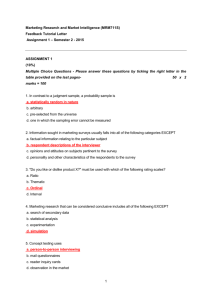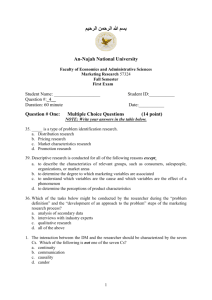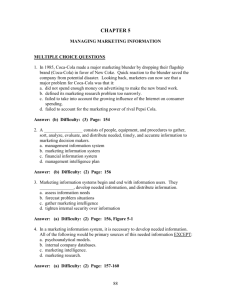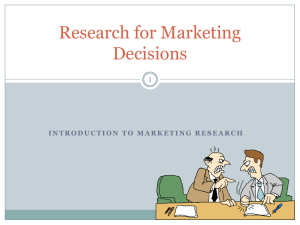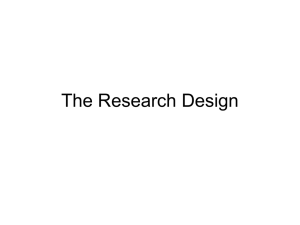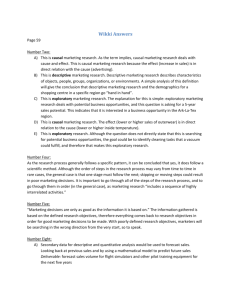essay questions
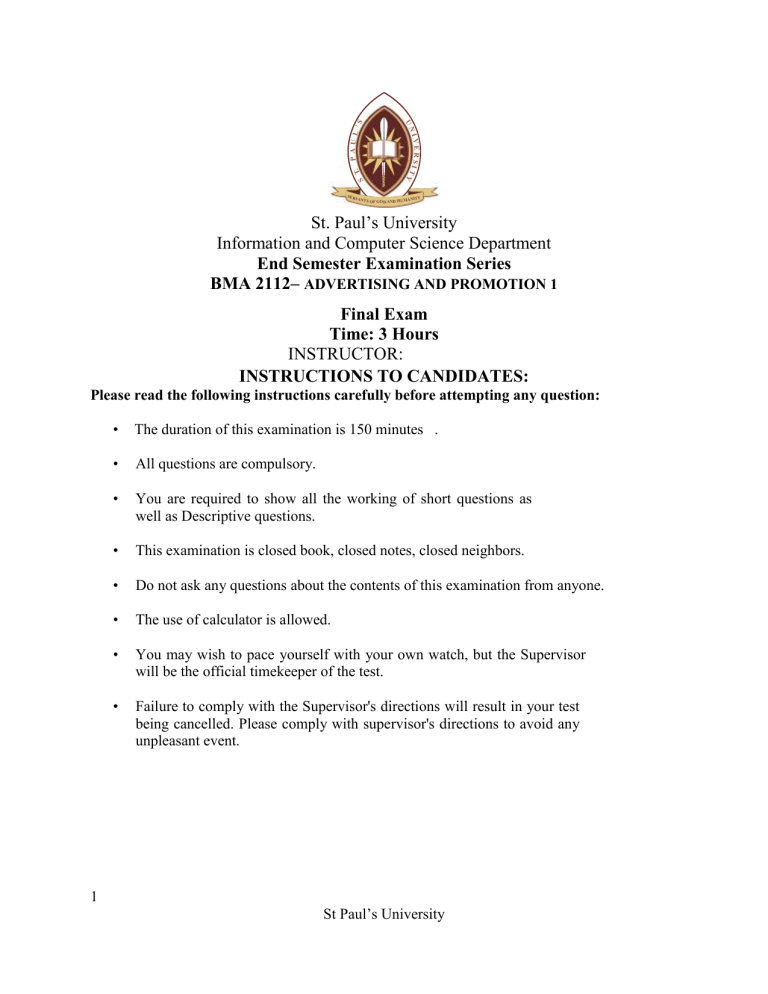
U
L
’ S
U
N
I
E
V
1
T
S
Y
T
SERVA
NTS OF GOD AND HUMAN
ITY
St. Paul’s University
Information and Computer Science Department
End Semester Examination Series
BMA 2112–
ADVERTISING AND PROMOTION 1
Final Exam
Time: 3 Hours
INSTRUCTOR:
INSTRUCTIONS TO CANDIDATES:
Please read the following instructions carefully before attempting any question:
• The duration of this examination is 150 minutes .
• All questions are compulsory.
•
You are required to show all the working of short questions as well as Descriptive questions.
•
This examination is closed book, closed notes, closed neighbors.
• Do not ask any questions about the contents of this examination from anyone.
•
The use of calculator is allowed.
•
You may wish to pace yourself with your own watch, but the Supervisor will be the official timekeeper of the test.
• Failure to comply with the Supervisor's directions will result in your test being cancelled. Please comply with supervisor's directions to avoid any unpleasant event.
St Paul’s University
MULTIPLE CHOICE QUESTIONS
1. In 1985, Coca-Cola made a major marketing blunder by dropping their flagship
Brand (Coca-Cola) in favor of New Coke. Quick reaction to the blunder saved the
Company from potential disaster. Looking back, marketers can now see that a
Major problem for Coca-Cola was that it: a) Did not spend enough money on advertising to make the new brand work. b) Defined its marketing research problem too narrowly. c) Failed to take into account the growing influence of the Internet on consumer spending. d) Failed to account for the marketing power of rival Pepsi Cola.
2. A _________________ consists of people, equipment, and procedures to gather,
Sort, analyze, evaluate, and distribute needed, timely, and accurate information to
Marketing decision makers. a) management information system b) marketing information system c) financial information system d) management intelligence plan
3. Marketing information systems begin and end with information users. They
_______________, develop needed information, and distribute information. a) assess information needs b) forecast problem situations c) gather marketing intelligence d) tighten internal security over information
4. In a marketing information system, it is necessary to develop needed information.
All of the following would be primary sources of this needed information EXCEPT: a) psychoanalytical models. b) internal company databases. c) marketing intelligence.
2
St Paul’s University
d) Marketing research.
5. A good marketing information system balances the information managers would like to have against: a) information that competitors have. b) information that is available . c) what they really need and what is feasible to offer. d) what is supplied by consultants .
6. One of the greatest problems in obtaining and accessing information that is relevant
to a marketing manager is: a) the intelligence of the manager. b) the cost of obtaining the information. c) the number of people that are seeking the information. d) a cataloging system for the information.
7. A(n) __________________ is a computerized collection of information obtained
from data sources within the company. a) retrieval system b) marketing research report c) flow diagram and a PERT chart d) internal database
8. Information in the company database can come from many sources. Which of the
following would not be chief among these sources? a) the accounting department b) the manufacturing department c) the marketing department d) interviews with stockholders
3
St Paul’s University
9. Which of the following information forms available to the marketing manager can
usually be accessed more quickly and cheaply than other information sources? a) marketing intelligence b) marketing research c) customer profiles d) internal databases
10. One of the most common problems with using internal information is that: a) since it was probably collected for some other purpose, it may be incomplete or b) wrong. c) it is usually expensive to retrieve. d) top executives are usually unwilling to relinquish data, therefore, the data has e) limits. f) the data is almost always unsecured and, therefore, suspect as to reliability.
11. ______________ is(are) the systematic collection and analysis of publicly available
information about competitors and developments in the marketing environment. a) Marketing research b) Internal company records c) Marketing intelligence d) Competitor analysis
12. The goal of marketing intelligence is to: a) improve strategic decision making. b) improve external security of the organization. c) prevent regulators from persecuting the company or its officers. d) monitor employees and ensure the company against leaks or fraud.
4
St Paul’s University
13. The systematic design, collection, analysis, and reporting of data relevant to a
specific marketing situation facing an organization is called: a.
Internal company records. b.
Marketing research. c.
Marketing implementation. d.
Marketing intelligence.
14. If Compaq Computers wants to know how many and what kinds of people or
companies will buy its new light-weight super-fast notebook computer, it would
probably undertake which of the following? a.
internal company records search b.
marketing research c.
marketing implementation analysis d.
marketing intelligence
15. Typical situations in which ________________ is used include market potential and
market share studies, assessments of customer satisfaction and purchase behavior,
and/or studies of pricing, product, distribution, and promotion activities. a.
marketing intelligence b.
marketing control c.
internal company records d.
marketing research
16. The first step in the formal marketing research process is best described as being one
where the marketing manager has to: a.
Define the problem and research objectives. b.
Interpret and report the findings. c.
Develop the research plan for collecting information. d.
Implement the research plan, and collect and analyze the data.
5
St Paul’s University
17. Managers believe that the hardest step to accomplish successfully in the marketing
research process is the one where the marketing manager has to: a.
Define the problem and research objectives. b.
Interpret and report the findings. c.
Develop the research plan for collecting information. d.
Implement the research plan, and collect and analyze the data.
18. When a manager knows that something is wrong, but is unsure of the specific causes,
the marketing research process is most likely to be in which of the following stages? a.
Define the problem and research objectives b.
Interpret and report the findings c.
Develop the research plan for collecting information d.
Implement the research plan, collect, and analyze the data
19. After the problem has been defined carefully, the next step in the marketing research
process is to: a) Develop the product concept. b) Develop the advertising campaign. c) Develop the research plan for collecting information. d) Proceed with collecting the information.
20. ________________ is marketing research to gather preliminary information that will
help define problems and suggest hypotheses. a.
Descriptive research b.
Causal research c.
Exploratory research d.
Experimental research
6
St Paul’s University
7
21. The type of research used to gather preliminary information to help generate research
hypotheses is called: a.
Descriptive research. b.
Causal research. c.
Exploratory research. d.
Experimental research.
22. __________________ is marketing research to better describe marketing problems,
situations, or markets. a.
Descriptive research b.
Causal research c.
Exploratory research d.
Experimental research
23. The type of research used to describe things such as the market potential for a product
is called: a.
Descriptive research. b.
Causal research. c.
Exploratory research. d.
Investigative research.
24. ___________________ is marketing research to test hypotheses about cause-and-
effect relationships. a.
Descriptive research b.
Causal research c.
Exploratory research d.
Experimental research
St Paul’s University
8
25. The type of research used to test hypotheses about cause-and-effect relationships is
called: a.
Descriptive research. b.
Causal research. c.
Exploratory research. d.
Investigative research.
26. The owner of a small men’s clothing store has noticed that sales for men’s suits are
especially high on Saturdays and at the end of the month. If he chooses to investigate
this phenomenon he would probably choose which of the following research formats? a.
Descriptive research b.
Causal research c.
Exploratory research d.
Investigative research
27. The second step of the marketing research process is ____________________.
During this step an outline of sources of existing data, specific research approaches,
contact methods, sampling plans, and instruments that researchers will use to gather
new data are presented. a.
Defining the problem and research objectives b.
Implementing the research plan c.
Developing the research plan for collecting information d.
Interpreting and reporting the findings
28. Research objectives can be translated into specific information needs. Which of the
following would not be a good example of such specific information needs that could
be matched to research objectives as applied to consumers? a.
Demographic, economic, and lifestyle characteristics of users b.
Consumer-usage patterns c.
Profit margins
St Paul’s University
d.
Attitudes toward proposed new packaging
9
29. __________________ is information that already exists somewhere, having been
collected for another purpose. a.
Experimental information b.
External information c.
Primary data d.
Secondary data
30. _________________ is information collected for the specific purpose at hand. a.
Experimental information b.
External information c.
Primary data d.
Secondary data
31. The first type of data normally collected and processed in a research effort is called
____________________ data. a.
Experimental b.
External c.
Primary d.
Secondary
32. _________________ are computerized collections of information available from
online commercial sources or via the Internet. a.
Internal databases b.
Intranet databases c.
Online databases d.
Synergistic databases
St Paul’s University
33. Which of the following would be a good example of an online database? a.
Linux b.
LEXIS-NEXIS c.
AOL d.
Quicken
34. All of the following are advantages of using secondary data EXCEPT: a.
Secondary data can be obtained from either internal or external sources. b.
Secondary data can be obtained more quickly than primary data. c.
Secondary data usually costs more (but is usually worth it) than primary data. d.
Secondary data can often provide data that an individual company cannot collect on its own.
35. Problems associated with secondary data include all of the following EXCEPT: a.
Consistency. b.
Relevancy. c.
Accuracy. d.
Current status (currency).
36. Designing a plan for primary data collection usually calls for decisions in all of the
following areas EXCEPT: a.
Payment methods. b.
Research approaches. c.
Contact methods. d.
Research instruments.
37. ________________ research is the gathering of primary data by observing relevant
people, actions, and situations. a.
Questionnaire b.
Observational
10
St Paul’s University
c.
Survey d.
Experimental
38. Steelcase office equipment company, when designing its highly successful Personal
Harbor modular office units, set up video cameras at various companies to study
motions and behavior patterns that customers themselves might not even notice.
This would be an example of which of the following research approaches? a.
Questionnaire research b.
Observational research c.
Survey research d.
Experimental research
39. A wide range of companies now use ___________ research—which combines
intensive observation with customer interviews—to gain deep insights into how
customers buy and live with their products. a.
Experimental b.
Dyad c.
Ethnographic d.
Experimental
40. A people meter or a checkout scanner would be examples of which of the following
forms of research? a.
Ethnographic b.
Survey c.
Experimental d.
Mechanical
41. ______________ is the gathering of primary data by asking people questions about
their knowledge, attitudes, preferences, and buying behavior. a.
Observational research b.
Survey research
11
St Paul’s University
c.
Experimental research d.
Mechanical research
42. The most widely used method for primary data collection is called: a.
Observational research. b.
Survey research. c.
Experimental research. d.
Mechanical research.
43. Electronic monitoring systems that link consumers’ exposure to television
advertising and promotion (measured using television meters) with what they buy
in stores (measured using store checkout scanners) are called: a.
Covert intelligence devices. b.
Single-source data systems. c.
Motivational research systems. d.
Subliminal persuasion measurement devices.
44. The major advantage of survey research is its: a.
Simplicity. b.
Structure. c.
Organization. d.
Flexibility.
45. ________________ is the gathering of primary data by selecting matched groups of
subjects, giving them different treatments, controlling related factors, and checking for
differences in group responses. a.
Observational research b.
Survey research c.
Experimental research d.
Mechanical research
12
St Paul’s University
46. Which of the following common survey methods is rated “excellent” for the control
of the sample? a.
Mail b.
Telephone c.
Personal d.
Online
47. Which of the following common survey methods is rated “poor” in terms of speed
of data collection? a.
mail b.
telephone c.
personal d.
online
48. Of all the survey contact methods available for the marketing researcher, the
_______________ method is the only one rated as “excellent” in the cost category
(it can collect many responses cheaply). a.
Mail b.
Telephone c.
Personal d.
Online
49. Which of the following common survey methods is rated “excellent” in terms of
flexibility? a.
Mail b.
Telephone c.
Personal d.
Online
13
St Paul’s University
50. When personal interviewing involves inviting six to ten people to gather for a few
hours with a trained interviewer to talk about a product, service, or organization, the
method is called: a.
Selective sponsorship. b.
Probing. c.
Focus group interviewing. d.
The Delphi method.
51. One of the problems with focus group interviewing is the potential for greater: a.
Interviewer bias. b.
Respondent boredom. c.
Respondent ignorance. d.
Interviewer incompetence.
52. Sam Moise goes to a local cybercafé once a week to participate in a unique form of
marketing research. He sits at one of the computers in the cafe, receives questions
from a pre-programmed disk, reads the questions, and types in his answers while an
interviewer is present in the cafe to monitor and assist with the process. Which of the
following would be the best description of the form of research in which Sam has just
been a participant? a.
Mechanical interviewing b.
Computer-assisted interviewing c.
Focus group interviewing d.
Online or internet interviewing
53. When a marketing research organization chooses a segment of the population that
represents the population as a whole, they have chosen a _______________. a.
Group b.
Bi-variant population c.
Sample
14
St Paul’s University
d.
Market target
54. Designing the sample in a research process requires three decisions. Which of the
Following is not one of those decisions? a.
Who is to be surveyed? b.
How many people are to be surveyed? c.
How should the people in the survey be chosen? d.
Who will check the accuracy of the sample?
55. When the researcher is using a _____________, each population member has a
known chance of being included in the sample. a.
Sampling unit b.
Sample size measure c.
Probability sample d.
Nonprobability sample
56. When the sampling error cannot be calculated due to the method used to select the
sample, the researcher has just used a(n): a.
Sampling unit sample. b.
Inverted sample. c.
Probability sample. d.
No probability sample.
57. If the researcher (because of time or cost constraints) selects the easiest population
members from which to obtain the information, he or she has just selected a(n): a.
Judgment sample. b.
Sample random sample. c.
Convenience sample. d.
Stratified random sample.
15
St Paul’s University
58. If the researcher is faced with a research problem wherein the population needs to be
divided into mutually exclusive groups (such as age groups), and random samples
are drawn from each group, the researcher has just selected a(n): a.
Judgment sample. b.
Sample random sample. c.
Convenience sample. d.
Stratified random sample.
59. If every member of the population has a known and equal chance of being chosen to
survey, then the researcher has just used a(n): a.
Judgment sample. b.
Sample random sample. c.
Convenience sample. d.
Stratified random sample.
60. Perhaps the most explosive issue facing online researchers concerns: a.
The extremely high costs of online research. b.
Consumer privacy. c.
Lack of accuracy with respondent responses. d.
Difficulty in verifying sample demographics.
61. ____________________ include all the possible answers, and subjects make choices
among them. a.
Closed-parameter questions b.
Open-end questions c.
Closed-end questions d.
Conditioned response questions
16
St Paul’s University
62. _________________ allow respondents to answer questions in their own words. a.
Closed-parameter questions b.
Open-end questions c.
Closed-end questions d.
Conditioned response questions
63. If a researcher wanted to measure a respondent’s physical responses with a
mechanical device, he or she could use a(n): a.
Galvanometer. b.
People meter. c.
Scanner. d.
Brain probe.
64. In recent years, many companies have acquired or developed special software and
analysis techniques called ________________for integrating and applying the
mountains of individual customer data contained in their databases. a.
Integration management b.
People probes c.
Customer relationship management d.
Psychographics
65. Francis Smith wishes to pull psychographic data about customers’ wants and desires
from the company’s database. The company has been maintaining elaborate records
about the wants and desires of its customers for years in what would now be called
a data warehouse. When Francis pulls the needed data gems from the data
warehouse, she has just participated in the process of: a.
Data research. b.
Nonmetric-multidimensional scaling. c.
Data mining.
17
St Paul’s University
d.
Data probing.
66. Increasingly, companies are allowing key customers and value-network members
to access account and product information and other data on a company’s _______
to update their accounts, arrange purchases, and check orders against inventories
to improve customer service. a.
Internet b.
Intranet c.
Web-net d.
Extranet
67. International marketing researchers follow _______________ steps as(than) domestic
researchers do. a.
The same b.
More reduced c.
More expanded d.
More primitive
68. All of the following would be among the problems faced by international researchers
EXCEPT: a.
The inability on the part of world consumers to understand marketing. b.
The scarcity of good secondary data in the international arena. c.
The respondents are more difficult to reach. d.
The cultural differences in the world community.
69. Increasing consumer resentment has become a major problem for the research
industry. For example, in a recent poll, _________ of Americans now refuse to
be interviewed in an average survey. a.
10 percent b.
20 percent
18
St Paul’s University
c.
25 percent d.
38 percent
70. One common misuse of marketing research findings in contemporary business is the
tendency for marketing research to: a.
Become a vehicle for pitching the sponsor’s products. b.
Become a vehicle for discriminating in the marketplace. c.
Become a means for raising prices.
TRUE/FALSE QUESTIONS
71. A system that uses people, equipment, and procedures to gather, sort, analyze,
evaluate, and distribute needed, timely, and accurate information to marketing
decision makers is called a marketing information system.
72. One of the components of an organization’s marketing information system is
marketing intelligence.
73. A good marketing information system balances the information users’ ability to pay
against a hierarchy of their needs.
74. By itself, information has no worth.
75. One of the problems with internal databases is the slowness of access and cost
associated with these information sources.
76. Marketing research is the systematic collection and analysis of publicly available
Information about competitors and developments in the marketing environment.
77. The first step in the marketing research process is to define the problem and research
objectives.
78. Descriptive research is marketing research to gather preliminary information that
will help define problems and suggest hypotheses.
79. The objective of causal research is to gather preliminary information that will
19 d.
Become a means for unfair competition.
St Paul’s University
help define the problem and suggest hypotheses.
80. Secondary data is information collected for the specific purpose at hand.
81. A good example of an online database is LEXIS-NEXIS.
82. Primary data can usually be obtained more quickly and at a lower cost than
secondary data.
83. Ethnographic research is used to gain deep insights into how customers buy and
live with their products.
84. One way to conduct observational research would be to use a people meter.
85. Observational research is the gathering of primary data by asking people questions
about their knowledge, attitudes, preferences, and buying behavior.
86. The mail survey technique is rated “excellent” in the flexibility category.
87. The telephone survey technique is rated as being “excellent” in the control of
sample category.
88. The only survey method that receives an “excellent” rating with respect to cost is the
online method of survey research.
89. Because interviewers have more freedom in personal interviews while conducting
a focus group, the problem of interviewer bias is very slight.
90. With a sample random sample, the researcher finds and interviews a prescribed
number of people in each of several categories.
91. With a stratified random sample, the population is divided into mutually exclusive
groups and the researcher draws a random sample from each group.
92. Open-end questions allow respondents to answer in their own words.
20
St Paul’s University
93. A customer touch point is a company-wide electronic storehouse of customer
information.
94. Marketing information has no value until it is used to make better marketing
decisions.
95. Because of the complexity and cost of secondary data collection, observation,
surveys, and experiments, small organizations with small budgets can rarely use
and benefit from marketing research done on an informal basis.
96. Many consumers feel positively about marketing research and believe that it serves
a useful purpose.
ESSAY QUESTIONS
97. In 1985, the Coca-Cola Company made a major marketing blunder when it introduced New
Coke. Describe what happened to Coca-Cola and the role that marketing research played in their decisions.
98. Considering the information presented in this chapter, explain the importance of information to a firm in today’s competitive environment.
99. Define the marketing information system and discuss its various parts.
100. Explain the differences between marketing intelligence, marketing research, and internal data (internal databases/and or records).
101. Describe an internal database and discuss the advantages and disadvantages of this form of marketing information.
102. Identify and describe the four steps in the marketing research process.
103. Describe exploratory, descriptive, and causal research. Point out the differences between the three forms of research.
21
St Paul’s University
104. Discuss what an online database is, give an example, and discuss how these databases may be of aid to a marketing manager.
105. Compare the advantages and disadvantages of the various methods for collecting survey information.
106. Discuss the focus group interviewing technique.
107. Discuss customer relationship management within the context of information acquisition and marketing research.
APPLICATION QUESTION
108. Ajax Apartment Development Corporation wants to construct a new multi-unit apartment complex in urban Boston. Since the undertaking will be very expensive, the company wants to determine in advance what type of consumer should be the target for occupancy promotions for the new building. At present, the company has not yet decided whether to build the building around “single-living,” “retirement,” or “multiple-person family” lifestyles and needs. A market research firm has been hired to investigate and make recommendations to the company. Which of the following sampling methods would you suggest to the marketing research firm to investigate this issue: a) sample random sample, b) stratified random sample, c) cluster (area) sample, d) convenience sample, e) judgment sample, or f) quota sample? (Note: you may use combinations of the various methods if you so choose.) Once you have decided on the method, justify your choice.
END
22
St Paul’s University
